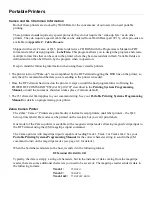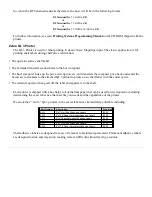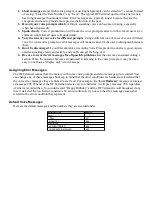
Base Connector
Pin #
Relay Connector
Receive Data +
5
Transmit Data +
Receive Data -
6
Transmit Data -
Transmit Data +
2
Receive Data +
Transmit Data -
3
Receive Data -
Make a cable with 5-5, 6-6, 2-2, and 3-3 (a straight cable); but, be careful that you select wires so that the 2
wire is in the twisted pair with the 3 wire, and the 5 wire is in the twisted pair with the 6 wire.
Do not use
pre-terminated Ethernet cables since the pairing is different.
For all RJ Cable pin numbers, number from left to right with the metal pin side of the connector facing you and
the cable running to the down position
Relay Test Plan and Failures
Relay Failure
Relay Station failures are often cable-related. If a Terminal puts out a “Who Can Hear Me?” message and a
Relay that is for some reason
not
connected to the Base Station (bad cable, cut cable, broken connectors)
hears it, it answers with the message:
Relay n Cannot Be
Heard by the Base
Notify Supervisor
Press Any Key
At this point, it is up to the operator to notify someone that the Relay is not communicating with the Base
and to check the cabling
first
. There is no message sent to the host, so it is very important that the operator
that receives this message notify someone immediately.
Because relay cabling is often troublesome, we supply a test cable for isolating the user-made cable from the
process. This test cable is so short that it doesn’t follow the rules of twists on the previous page – it is just a
Ethernet patch cable for node, but adequate for testing the relay.
HINT
: Use the suggested wire type, and if you’re doing your own crimping, be sure to use the expensive metal
crimpers ($100) and not the cheap plastic crimpers ($15). Get someone familiar with making network (Ethernet)
cables, but be sure to tell them
not
to use the Ethernet pin outs for the Relay Stations, (it has been tried more
than once!).
Testing the Relay
To test communication with a Relay, first check out the radio by doing a Site Test on the offending Relay
with all other Relays and Bases OFF. To check if a Relay is working with a Base Station, set the Base to a
different
channel than the Relay and set the Terminal channel to match the Relay channel. Then cable-
connect the Relay to the Base (“Relay” port to “Relay” port).
Start your application on the host or use one of our demo programs provided with the Terminal (it’s a good
way to test) - it takes 10 or more seconds for the Terminal to switch to the Relay. The delay is a result of the
Terminal having to put out a "who can hear me" message when it doesn't get a response from the Base
Station. The Relay responds to the Terminals "who can hear me" message and communication is established
through the Relay. You will notice slightly slower throughput when working through the Relay.
Relay ID and Channel…
Содержание 7000 Series
Страница 1: ......
Страница 99: ... Data with check digit is 943457823 ...
















































